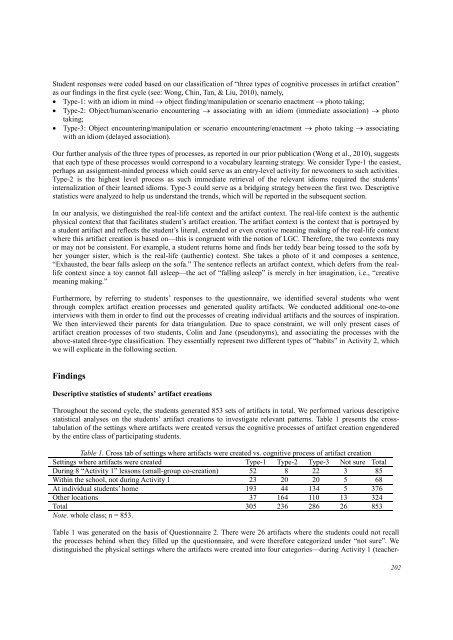Download Complete Issue in PDF - Educational Technology & Society
Download Complete Issue in PDF - Educational Technology & Society
Download Complete Issue in PDF - Educational Technology & Society
Create successful ePaper yourself
Turn your PDF publications into a flip-book with our unique Google optimized e-Paper software.
Student responses were coded based on our classification of “three types of cognitive processes <strong>in</strong> artifact creation”<br />
as our f<strong>in</strong>d<strong>in</strong>gs <strong>in</strong> the first cycle (see: Wong, Ch<strong>in</strong>, Tan, & Liu, 2010), namely,<br />
• Type-1: with an idiom <strong>in</strong> m<strong>in</strong>d → object f<strong>in</strong>d<strong>in</strong>g/manipulation or scenario enactment → photo tak<strong>in</strong>g;<br />
• Type-2: Object/human/scenario encounter<strong>in</strong>g → associat<strong>in</strong>g with an idiom (immediate association) → photo<br />
tak<strong>in</strong>g;<br />
• Type-3: Object encounter<strong>in</strong>g/manipulation or scenario encounter<strong>in</strong>g/enactment → photo tak<strong>in</strong>g → associat<strong>in</strong>g<br />
with an idiom (delayed association).<br />
Our further analysis of the three types of processes, as reported <strong>in</strong> our prior publication (Wong et al., 2010), suggests<br />
that each type of these processes would correspond to a vocabulary learn<strong>in</strong>g strategy. We consider Type-1 the easiest,<br />
perhaps an assignment-m<strong>in</strong>ded process which could serve as an entry-level activity for newcomers to such activities.<br />
Type-2 is the highest level process as such immediate retrieval of the relevant idioms required the students’<br />
<strong>in</strong>ternalization of their learned idioms. Type-3 could serve as a bridg<strong>in</strong>g strategy between the first two. Descriptive<br />
statistics were analyzed to help us understand the trends, which will be reported <strong>in</strong> the subsequent section.<br />
In our analysis, we dist<strong>in</strong>guished the real-life context and the artifact context. The real-life context is the authentic<br />
physical context that that facilitates student’s artifact creation. The artifact context is the context that is portrayed by<br />
a student artifact and reflects the student’s literal, extended or even creative mean<strong>in</strong>g mak<strong>in</strong>g of the real-life context<br />
where this artifact creation is based on—this is congruent with the notion of LGC. Therefore, the two contexts may<br />
or may not be consistent. For example, a student returns home and f<strong>in</strong>ds her teddy bear be<strong>in</strong>g tossed to the sofa by<br />
her younger sister, which is the real-life (authentic) context. She takes a photo of it and composes a sentence,<br />
“Exhausted, the bear falls asleep on the sofa.” The sentence reflects an artifact context, which defers from the reallife<br />
context s<strong>in</strong>ce a toy cannot fall asleep—the act of “fall<strong>in</strong>g asleep” is merely <strong>in</strong> her imag<strong>in</strong>ation, i.e., “creative<br />
mean<strong>in</strong>g mak<strong>in</strong>g.”<br />
Furthermore, by referr<strong>in</strong>g to students’ responses to the questionnaire, we identified several students who went<br />
through complex artifact creation processes and generated quality artifacts. We conducted additional one-to-one<br />
<strong>in</strong>terviews with them <strong>in</strong> order to f<strong>in</strong>d out the processes of creat<strong>in</strong>g <strong>in</strong>dividual artifacts and the sources of <strong>in</strong>spiration.<br />
We then <strong>in</strong>terviewed their parents for data triangulation. Due to space constra<strong>in</strong>t, we will only present cases of<br />
artifact creation processes of two students, Col<strong>in</strong> and Jane (pseudonyms), and associat<strong>in</strong>g the processes with the<br />
above-stated three-type classification. They essentially represent two different types of “habits” <strong>in</strong> Activity 2, which<br />
we will explicate <strong>in</strong> the follow<strong>in</strong>g section.<br />
F<strong>in</strong>d<strong>in</strong>gs<br />
Descriptive statistics of students’ artifact creations<br />
Throughout the second cycle, the students generated 853 sets of artifacts <strong>in</strong> total. We performed various descriptive<br />
statistical analyses on the students’ artifact creations to <strong>in</strong>vestigate relevant patterns. Table 1 presents the crosstabulation<br />
of the sett<strong>in</strong>gs where artifacts were created versus the cognitive processes of artifact creation engendered<br />
by the entire class of participat<strong>in</strong>g students.<br />
Table 1. Cross tab of sett<strong>in</strong>gs where artifacts were created vs. cognitive process of artifact creation<br />
Sett<strong>in</strong>gs where artifacts were created Type-1 Type-2 Type-3 Not sure Total<br />
Dur<strong>in</strong>g 8 “Activity 1” lessons (small-group co-creation) 52 8 22 3 85<br />
With<strong>in</strong> the school, not dur<strong>in</strong>g Activity 1 23 20 20 5 68<br />
At <strong>in</strong>dividual students’ home 193 44 134 5 376<br />
Other locations 37 164 110 13 324<br />
Total 305 236 286 26 853<br />
Note. whole class; n = 853.<br />
Table 1 was generated on the basis of Questionnaire 2. There were 26 artifacts where the students could not recall<br />
the processes beh<strong>in</strong>d when they filled up the questionnaire, and were therefore categorized under “not sure”. We<br />
dist<strong>in</strong>guished the physical sett<strong>in</strong>gs where the artifacts were created <strong>in</strong>to four categories—dur<strong>in</strong>g Activity 1 (teacher-<br />
202

















